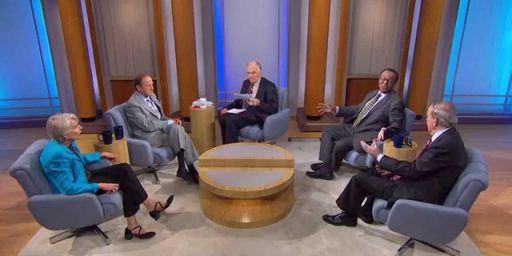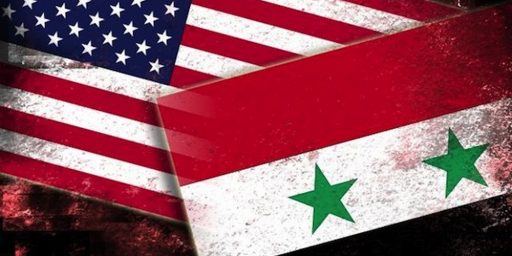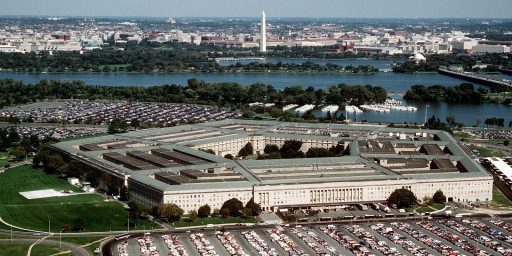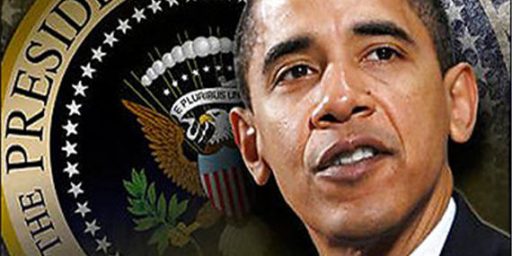Woodward Book, Part II
WaPo has the second installment of its Bob Woodward book excerpts, “With CIA Push, Movement to War Accelerated.” The lead-in notes that the CIA’s Iraq section chief briefed Vice President Cheney that military action was the only realistic option for removing Saddam, in that he was coup proof and we had fewer than five agents in Iraq.
The other bit of news, that’s not really news at this point, is that the CIA’s estimates on WMD were based on old information.
The CIA had never declared categorically that it believed Hussein possessed weapons of mass destruction. The formal December 2000 National Intelligence Estimate (NIE) concluded that Hussein “retained a small stockpile” of chemical warfare agents — not actual warheads — perhaps up to 100 metric tons, and “might” have precursors for 200 metric tons more. This conclusion was drawn largely from accounting discrepancies between what Iraq had previously told U.N. weapons inspectors it possessed, and what records showed had been destroyed.
The classified NIE on biological weapons concluded that Iraq “continued” to work on development and was poised to have them.
Significantly, in public testimony before the Senate intelligence committee on Feb. 6, 2002, on worldwide threats, Tenet had not mentioned Iraq until page 10 of his 18-page statement, devoting only three paragraphs to Iraq.
Senate Democrats pressed the administration to provide a new comprehensive intelligence report or estimate on Iraq, and Tenet agreed reluctantly to do a rushed NIE on Iraq’s weapons of mass destruction capability in the fall of 2002. The National Intelligence Council, a group of representatives from the key agencies, began sifting, sorting and assessing the raw intelligence. The council included the CIA; the National Security Agency, which does communications intercepts; the Pentagon’s Defense Intelligence Agency; the State Department’s intelligence bureau; the Energy Department’s intelligence arm; and the National Imagery and Mapping Agency, which performs satellite and other overhead reconnaissance.
The group had a massive amount of material, much of it old and not very reliable. Iraq was still one of the hardest intelligence targets. Hussein had improved his methods of deception and hiding his weapons programs — whatever they might be — underground. CIA human intelligence inside Iraq was still weak, and paramilitary teams such as those headed by Tim in northern Iraq had found nothing.
***
Stuart A. Cohen, an intelligence professional for 30 years, was acting chairman of the National Intelligence Council when the Iraq assessment of WMD was being prepared. He confided to a colleague that he wanted to avoid equivocation, if possible. If the Key Judgments used words such as “maybe” or “probably” or “likely,” the NIE would be “pablum,” he said. Ironclad evidence in the intelligence business is scarce and analysts need to be able to make judgments beyond the ironclad, Cohen felt. The evidence was substantial but nonetheless circumstantial; no one had proof of a vial of biological agents or weapons, or a smoking vat of chemical warfare agents. Yet coupled with the incontrovertible proof that Saddam Hussein had had WMD in the past — U.N. weapons inspectors in the 1990s had found them, tested them and destroyed them — the conclusion seemed obvious.
The alternative view was that Hussein no longer had such weapons. No one wanted to say that because so much intelligence would have to be discounted. The real and best answer was that he probably had WMD, but that there was no proof and the case was circumstantial. Given the leeway to make a “judgment,” which in the dictionary definition is merely an “opinion,” the council was heading toward a strong declaration. No pablum.
Analysts at the CIA had long discussed the issue of avoiding equivocation. At times, many, including John McLaughlin, felt that they had to dare to be wrong to be clearer in their judgments. That summer McLaughlin had told the National Security Council principals that the CIA thought it had a pretty good case that Hussein had WMD, but that others would demand more direct proof. The CIA did not have an anthrax sample, and didn’t have a chemical weapons sample in hand.
This strikes me as quite credible. Intelligence agencies have come under a lot of fire in recent years for being too careful, playing the CYA game, and too much “one the one hand this, on the other hand that.” That’s not of much use to policy makers.
The question here is whether CIA made clear to policy makers that there were questions about the data. It’s possible to both give a strong policy recommendation based on the best available data and let the policy maker know that the data is old and there are questions about parts of it.





